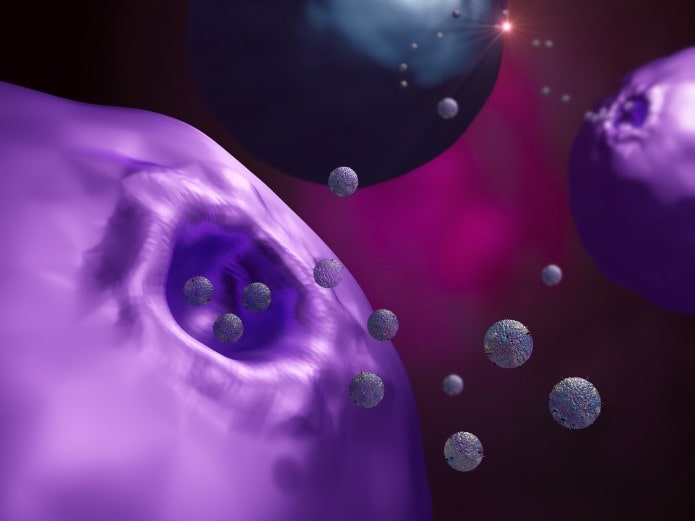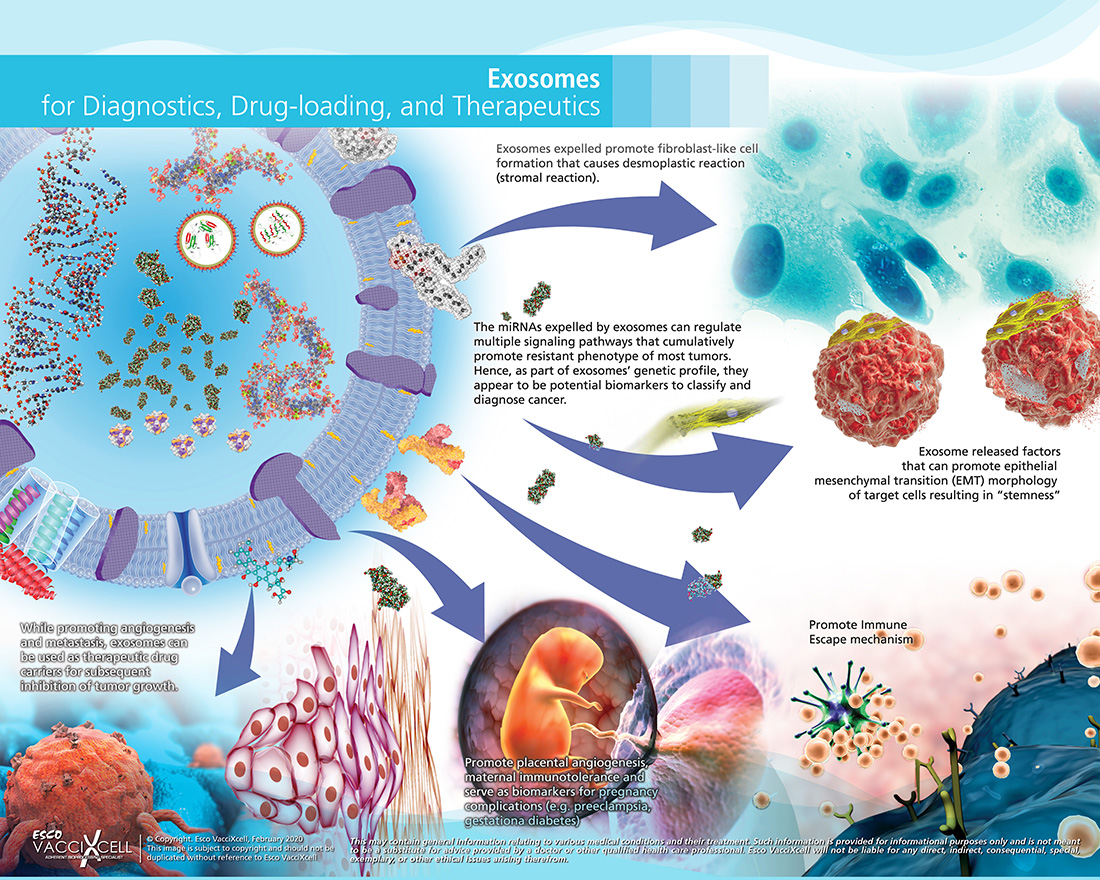Applications
What Do Exosomes Do?

Exosomes are secreted nanovesicles that are present in all body fluids under both normal and pathophysiological conditions. They have been recognized for their role in mediating intercellular communication by serving as carriers of different biomolecules, including proteins, genetic materials, and lipids.
Exosomes are small, membrane-bound vesicles that are secreted by cells into the extracellular environment. They are typically 30-150 nanometers in size and contain a variety of molecules, including proteins, lipids, and nucleic acids such as RNA and DNA. Exosomes are important for intercellular communication and are involved in various biological processes, such as immune responses, tissue repair, and cancer progression. They can be isolated from various bodily fluids, such as blood or urine, and can serve as biomarkers for disease. Additionally, exosomes can be engineered to deliver specific cargo, such as drugs or therapeutic molecules, to target cells or tissues.
Types of Exosomes
Exosomes can be classified into different types based on their origin, composition, and function. Here are some of the types of exosomes:
- Endosome-derived exosomes: These are the most common type of exosomes and are formed by the inward budding of the endosomal membrane.
- Plasma membrane-derived exosomes: These exosomes are formed by the outward budding of the plasma membrane.
- Dendritic cell-derived exosomes: These exosomes are produced by dendritic cells and are involved in immune regulation.
- Tumor-derived exosomes: These exosomes are produced by tumor cells and are involved in cancer progression by promoting tumor growth, angiogenesis, and metastasis.
- Mesenchymal stem cell-derived exosomes: These exosomes are produced by mesenchymal stem cells and are involved in tissue repair and regeneration.
- Blood cell-derived exosomes: These exosomes are produced by various blood cells such as red blood cells, platelets, and white blood cells, and are involved in intercellular communication and immune regulation.
These several types of exosomes play important roles in various biological processes and have the potential to serve as diagnostic and therapeutic tools in a wide range of diseases.
Applications
Exosomes have several potential applications when it comes to bioprocessing, which is the use of biological systems and organisms to manufacture products or perform specific functions. Here are some of the applications of exosomes in bioprocessing:
Cell-free protein production: Exosomes can be used as a cell-free system for protein production. Exosomes can be loaded with specific proteins and used as a delivery vehicle for protein production. This approach can simplify the process of protein production and eliminate the need for cell culture.
Drug delivery: Exosomes have the potential to serve as a delivery system for targeted drug administration. Exosomes can be engineered to carry specific drugs and target specific cells or tissues. This approach can improve the efficacy and safety of drugs by reducing off-target effects.
Biologics manufacturing: Exosomes can be used to produce biologics, such as monoclonal antibodies, recombinant proteins, and vaccines. Exosomes can be used to deliver the genes that encode these biologics to the cells that produce them.
Regenerative medicine: Exosomes can be used in regenerative medicine to promote tissue repair and regeneration. Exosomes can be engineered to carry specific growth factors and cytokines that promote tissue repair.
Biosensors: Exosomes can be used as biosensors to detect specific molecules or biomarkers. Exosomes can be engineered to carry specific receptors or probes that bind to these molecules or biomarkers. This approach can enable the development of highly sensitive and specific biosensors.
Agriculture: Exosomes can be used in agriculture to deliver nutrients, pesticides, and other agents to plants. Exosomes can be engineered to carry these agents and target specific plant tissues or cells. This approach can improve the efficacy and safety of agricultural products.
Exosomes Workflow

Exosomes for Diagnostics, Drug-loading and Therapeutics
Due to their ability to carry cargo and communicate with target cells, exosomes have a broad range of potential applications in the fields of diagnostics, drug-loading, and therapeutics.
Diagnostics:
Exosomes are being explored as a potential source of biomarkers for disease diagnosis and prognosis. They are stable in biological fluids and can reflect the state of the cell that released them. Several studies have demonstrated that exosomes can be used as biomarkers for cancer, infectious diseases, and other conditions. The specific cargo of exosomes can be analyzed to identify biomolecules such as proteins, RNA, and DNA that are indicative of disease. Exosomes can be isolated from biological fluids such as blood, urine, and cerebrospinal fluid, making them an attractive source of liquid biopsy.
Drug-loading:
Exosomes can be engineered to carry therapeutic molecules such as drugs, RNA, or proteins. This can enhance their therapeutic potential and make them more selective in targeting specific cells. By loading exosomes with drugs, they can be delivered to target cells and tissues more efficiently. Exosomes can also be modified to increase their stability and prolong their circulation time in the body. This approach reduces the risk of off-target effects, improves drug efficacy, and minimizes toxicity.
Therapeutics:
Exosomes can be used as a natural carrier for delivering therapeutic molecules such as RNA and proteins to target cells. By engineering exosomes to carry specific therapeutic molecules, they can be targeted to specific cells or tissues, reducing the risk of side effects and increasing therapeutic efficacy. Exosomes can also be engineered to carry RNA molecules that inhibit the expression of specific genes that contribute to disease, including cancer, inflammation, and neurodegeneration.
In summary, exosomes have a broad range of potential applications in the fields of diagnostics, drug-loading, and therapeutics. They have several advantages over traditional drug delivery methods, including improved selectivity, reduced toxicity, and increased stability. As research in the field of exosomes continues, it is likely that their potential applications will continue to expand, making them a promising tool in biomedicine.
Revolutionizing Exosome Production with ESCO Vaccixcell Tide Motion Bioreactors
Esco VacciXcell’s Tide Motion bioreactors are a type of bioreactor used for the production of exosomes. These bioreactors utilize a patented Tide Motion technology that mimics the gentle upward and downward movement of the culture medium, similar to the cyclical high and low tide of bodies of water on earth. This gentle oscillation eliminates shear stress during culture and provides a suitable and gentle environment for cells to grow and secrete exosomes.
The Tide Motion technology provides high surface-to-volume ratios for culturing cell lines at high densities, allowing for the growth of up to 10 billion cells per gram using BioNOC II macrocarrier, the packed bed component of the Tide Motion bioreactors. BioNOC II is configured in 3D, mimicking the in-vivo environment of the cell line, allowing cells to grow on the surface of the fibers and spaces in between them. As a highly porous carrier, nutrients and oxygen can penetrate the bed, allowing cell lines to grow post-confluence.
Tide Motion bioreactors have several advantages over traditional bioreactors in the production of exosomes. The gentle oscillation of the culture medium eliminates shear stress and offers perfusion-based cultures and 100% media exchange for adequate mass transfer. Production can be done continuously for several months, resulting in a more concentrated conditioned medium as the exosome product is retained within the culture compartment. Furthermore, Tide Motion bioreactors generate low lint waste at the end of the production, easing purification steps.
References:
- Colombo, M., Raposo, G., & Théry, C. (2014). Biogenesis, secretion, and intercellular interactions of exosomes and other extracellular vesicles. Annual Review of Cell and Developmental Biology, 30, 255-289. doi: 10.1146/annurev-cellbio-101512-122326
- Yáñez-Mó, M., Siljander, P. R., Andréu, Z., Zavec, A. B., Borras, F. E., Buzas, E. I., ... & De Wever, O. (2015). Biological properties of extracellular vesicles and their physiological functions. Journal of Extracellular Vesicles, 4(1), 27066. doi: 10.3402/jev.v4.27066
- Mathieu, M., Martin-Jaular, L., Lavieu, G., & Théry, C. (2019). Specificities of secretion and uptake of exosomes and other extracellular vesicles for cell-to-cell communication. Nature Cell Biology, 21(1), 9-17. doi: 10.1038/s41556-018-0250-9
- Kalluri, R., & LeBleu, V. S. (2020). The biology, function, and biomedical applications of exosomes. Science, 367(6478), eaau6977. doi: 10.1126/science.aau6977
- Chen, G., Huang, A. C., Zhang, W., Zhang, G., Wu, M., Xu, W., ... & Zhang, X. (2018). Exosomal PD-L1 contributes to immunosuppression and is associated with anti-PD-1 response. Nature, 560(7718), 382-386. doi: 10.1038/s41586-018-0392-8
- Vader, P., Mol, E. A., Pasterkamp, G., & Schiffelers, R. M. (2016). Extracellular vesicles for drug delivery. Advanced Drug Delivery Reviews, 106, 148-156. doi: 10.1016/j.addr.2016.02.006





